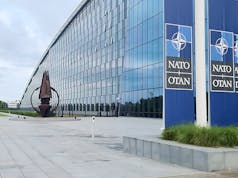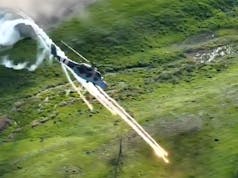A resistance group of Crimean Tatars, an ethnic group native to the Russian-occupied peninsula, is now a prominent player in the Ukraine war.
The Atesh (fire) movement has pledged to wage an unending war on the Russian invaders of Ukraine.
Founded in September 2022, Atesh seeks to disrupt logistics, sabotage key targets, and stoke discontent against – and within – Russian president Vladimir Putin’s army.
Written by Gerald Hughes, Reader in Military History and Intelligence Studies in the Department of International Politics, Aberystwyth University.This article is the opinion of the author and not necessarily that of the UK Defence Journal. If you would like to submit your own article on this topic or any other, please see our submission guidelines.
Atesh’s methods are ruthless, as witnessed by the killing of 30 Russian servicemen in hospitals in Simferopol in November 2022. Their methods are also effective. In February 2023, the group claimed that over 4,000 Russian soldiers had already taken an online course (at the ‘Atesh school’) on how to survive the war by sabotaging their own equipment.
Mustafa Dzhemilev, the Crimean Tatar leader who Russia has barred from Crimea until 2034, recently stated that “Atesh is very deep underground … but they are working inside Crimea … blowing up targets.”
Serhii Kuzan, head of the Kyiv-based thinktank the Ukrainian Center for Security and Cooperation, said that: “The idea is for the occupier to always feel the presence of the partisans and for them never to feel safe.”
Partisans including Atesh are using a variety of methods to undermine the Russians in Crimea and beyond. When Atesh claimed responsibility for “liquidising” the Russian soldiers in the hospitals in Simferopol it warned: “Check the wards, check the morgues … you can check this fact 300 times but it’s the truth”.
As with so many incidents in this war, and this goes for acts committed by all sides, verifying such claims is an exceedingly difficult task. What we do know is that the partisan forces in Kharkiv, Zaporizhzhia and Kherson regions recently carried out a coordinated sticker and flyer campaign against the so-called Russian world.
In addition, emulating a tactic adopted in previous conflicts, Ukraine has reportedly dropped leaflets on Russian positions with the message: “Russian soldier, if you don’t want to be a Nazi of the 21st century, then leave our land! Otherwise, the fate of Hitler’s soldiers and a Nuremberg tribunal await you!”
The appeal to the past is seductive for Kyiv as partisan warfare played a major part in winning both the Russian civil war (1917-1923) and what Russia remembers as the “great patriotic war” (1941-1945).
The comparison of the current Russian army to the Nazi invaders of the second world war completely contradicts Putin’s version of history. The Kremlin charges that Ukrainian nationalists collaborated and engaged in mass murder during the Nazi occupation. Russian propaganda claims that the current war is designed to “de-Nazify” Ukraine.
Who are the Tatars?
Those who know the history of Russia, Ukraine and the Crimean Tatars will not be surprised by the hostility of the latter to the latest manifestation of Muscovite imperialism. Unlike the Slavic Russians, the Crimean Tatars are a Turkic ethnic group native to the Crimean peninsula.
The Crimean Tatar nation formed over four centuries (c.1200-c.1650) and merged with waves of immigrants. Tsarina Catherine the Great annexed Crimea in 1783 and the Russian Empire subsequently sought to “Russianise” the Crimean Tatars, prior to the revolution of 1917.
Under the rule of Joseph Stalin (1924-1953), the Soviet Union engaged in the active repression of the Crimean Tatars. This led to a number of Tatars cooperating with the Germans following the Nazi invasion of June 1941.
Stalin accused the Crimean Tatars of treachery and deported the community en masse to the Gulag. Although some Crimean Tatars served with the Axis powers, rather more served in the Red Army.
This deportation of at least 180,000 persons to central Asia in 1944 was one of the most painful chapters in Tatar history, (remembered as Sürgün (the exile). In the 1960s, research by Tatar activists estimated that approximately 100,000 of these people died (and even Soviet records show that 30,000 Crimean Tatars died less than two years after the deportations).
Only in September 1967 did the Supreme Soviet – the highest legislative body in the USSR – acknowledge that the charge of treason against the entire Crimean Tatar nation had been “unreasonable”. Thirteen years earlier, the Supreme Soviet had voted to transfer Crimea to the Ukrainian Soviet Socialist Republic from the Russian Soviet Federative Socialist Republic.
This was not that controversial at the time, given that both entities were then constituent parts of the Soviet Union. The dissolution of the Soviet Union in 1991 changed all of that.
Most of the Tatars were only allowed to return to Crimea in 1989, under the reformist Soviet leader Mikhail Gorbachev. The Tatars did not receive any compensation for their losses, and their return home prompted tensions with ethnic Russians and Ukrainians, many of whom had moved to the peninsula after 1944.
Once Ukraine became independent in 1991, Tatar leaders claimed that authorities in Kyiv deliberately prevented their people from obtaining government jobs, while secretly allowing “land grabs”. Gradually, however, the common enemy pushed the Crimean Tatars and Ukraine together.
Crimean Tatars became ardent supporters of the new Ukrainian state, and were sometimes dubbed “the greatest Ukrainians in Crimea”.
In 1897 native Crimean Tatars made up 34.1% of the population of Crimea. Despite the reversal of Stalin’s ethnic cleansing, by 2001 Russians made up 58% of the Crimean population while the indigenous Tatars represented only 12%.
The invasion of Crimea by Russia in 2014 was a disastrous return to the past for the Crimean Tatars. The Russians immediately embarked upon a programme of systematic tyranny. These persecutions persist to this day.
The Crimean Tatar self-governing assembly, the Mejlis, of which Mustafa Dzhemilev was chair, was banned, as were public references to the Stalinist deportations. After 2014, thousands of Tatars left Russian-occupied Crimea for Ukraine. Tatar activist and politician Ilmi Umerov told the Russian Federal Security Service that “I do not consider Crimea part of the Russian Federation.” He was sent to a psychiatric hospital.
Demonstrating Ukrainian-Tatar solidarity, in November 2015, the Verkhovna Rada (the Ukrainian parliament) passed a motion denouncing the 1944 deportations as “genocide”. (A precedent that encouraged Latvia, Lithuania and Canada to follow suit in 2019.) In 2021 the Verkhovna Rada passed a law which recognised the Crimean Tatars as one of the indigenous peoples of Ukraine.
As long as the current war continues, and given the significant military contribution of the Crimean Tatars, Kyiv will look ever more favourably on the question of self-determination for the Crimean Tatar nation.
Ukrainian studies academic Rory Finnin argues that the future of the Crimea is central to any settlement that may follow the current war. Ukraine lost control of Crimea in 2014, but the exertions of the Crimean Tatars in the present conflict are contributing significantly to Kyiv’s ability to avoid defeat by Russia.![]()
This article is republished from The Conversation under a Creative Commons license. Read the original article.














The original Crimean Tatars were deported by Stalin during WW2 probably because their papers were not in order. Stalin, a highly paranoid Georgian, was also prone to shooting in the head those whom he suspected of disloyalty. Millions of them. The Crimean Tatars were lucky
I agree we all know the Russians have carried out many atrocities throughout the war but killing wounded servicemen in a hospital has echos of the Japanese in WW2.
Killing servicemen in hospital? – Abhorent & surely a war crime.
Look up the Katyn massacre of Polish officers by the NKVD
Both sides did it mate.
NKVD had Katyn. the Nazis had the Einsatzgruppen.
And they were assisted by Latvians and by Ukrainians. The Arajas Commando, which was absorbed into 15th SS Division, a Latvian formation, and by the “Trawniki” men, Ukrainians who served in the Death and Concentration Camps, helped destroy the Jews in Warsaw in 43, and also formed Auxiliary Police units to help Einsatzgruppe D from 41 to late 43 early 44.
In that historical fact, at least, the Russians are correct. That they use it as a pretext to attack saying Ukraine still has Nazi sympathies is not.
Interesting to compare with the current conflict and the behaviour of the two sides. One has committed thousands of war crimes and destruction of civil infrastructure while the other only strikes military or political targets. Unlikely to be a fully black and white situation as mistakes are inevitable in battle but clear enough which is the terrorist state I believe.
Slava Ukraine!
#StandWithUkraine
Agreed.
Never heard of them Daniele but just looked it up.
One thing I would take from it was that they were not Army but auxiliary police (AP) and getting a mob(AP) together in any country is not hard.
The concentration camp was not in Salaspils but between Salaspils and Rīga.
Morning David.
When I was typing that I wondered if you of all people would read and comment, considering your connections there. 👍
Yes, the originals were not army, just violent anti semites that the Nazis gathered, like in Lithuania, for Pogroms against the Jewish population. After, they merged into the “Latvian Legion”
( I have an excellent book on them ) part of the Waffen SS.
They were very active at Rumbula, a massacre you must be aware of, alongside German SD.
I know.
However, concentration camps are nothing new; who invented them?
As Cumbria has changed to Cumberland, I do wonder what our fellow British in Scotland feel about the new name of a neighbouring County.
After all, Butcher, the Duke of Cumberland can not resonate very well, can it?
Likewise, our massacre at Amritsar is up there with elements of the holocaust as well.
500 Latvians committed unspeakable crimes, and yet the Slovaks were the most successful in annihilation of their Jewish citizens, better even than the NAZIS.
Context is everything.
I’m sure it is, mate. But I was not listing every perpetrator, just giving two examples as this article is about Ukraine, and thus the parallels of the Eastern Front, as David mentioned the NKVD?
I am aware of that , but to use what aboutery makes no difference to me. Either both are wrong or neither are.
There are many instances in history of combatants killing wounded servicemen and civilians in hospital, I do not condone this sort of thing at all.
The Talibs once went through an Afghan maternity hospital and shot dead over a hundred women and their babies. Deranged men in the USA arm themselves with AR-15 automatic weapons and shoot primary school kids and then themseves. Turkey killed thousands of Christian Armenians on a death march. The Nazis killed six million jews.
All these examples of inhumanity are appalling and cannot be excused or justified. But I dare say that it is going on on both sides in the UkR war.